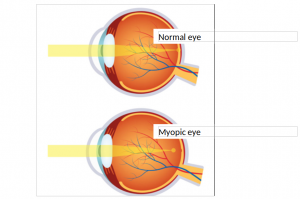Myopia

In a myopic eye the rays of light are not focused on the retina but in front of it. Thus, the objects at a distance are not clearly seen. The most common cause is the increased length of the eye globe.

It is the most common refractive abnormality in both children and adults. It is now considered a global epidemic. It is estimated that more than 40% of Americans are myopic and that this percentage is increasing, especially among school-age children. A statistical study has shown that the prevalence of myopia has increased by 8% in the last 15 years. In general myopia usually stabilizes in adulthood.
However, there are exceptions to this rule. Myopia can sometimes worsen in adulthood for many reasons, such as:
- Excessive use of electronic device monitors
- Eye injury
- Surgery
- Diabetes mellitus, Marfan syndrome, etc.
Treatment
Although there is no cure for myopia, there are several management and control methods that prove effective.
Laser surgery ( LASIK, PRK)
In adults myopia can be corrected through refractive laser beam surgery.
The use of corrective glasses or contact lenses corrects myopia by making the rays of light diverge and thus focus directly on the retina.
Myopia in children
Myopia in children works differently. Because the eye is still in an active state of development, the progression of myopia can slow down.
Ophthalmic drops of atropine have been shown to significantly slow the progression of myopia in children. Two major trials in Asia found that atropine drops slow the progression of myopia in children by 50% -60%. However, because myopia is not fully curable, children using atropine drops may need to wear glasses or contact lenses.
Multifocal glasses & contact lenses
A study conducted by the American Association of Optometrists (CLCS) found that children who wore multifocal lenses saw the progression of their myopia slower by about 25% and had 31% less axial elongation (longer axial eye length) than children who wore monofocal lenses.
Orthokeratology
Also known as ortho-k, orthokeratology uses specially designed air permeable contact lenses to temporarily flatten the cornea during sleep. In the morning, the lenses are removed, and the vision remains clear without the use of contact lenses or glasses. Ortho-k has been shown to slow myopic progress in children by 36% – 56%.
Natural light and outdoor activity
Recent trials show that children who spend more time outdoors (up to 14 hours a week or more) experience more often no or less myopia than children who spend less time outdoors.
Use of bright electronic devices
Many studies show that activities such as long phone or computer use are associated with myopia.

